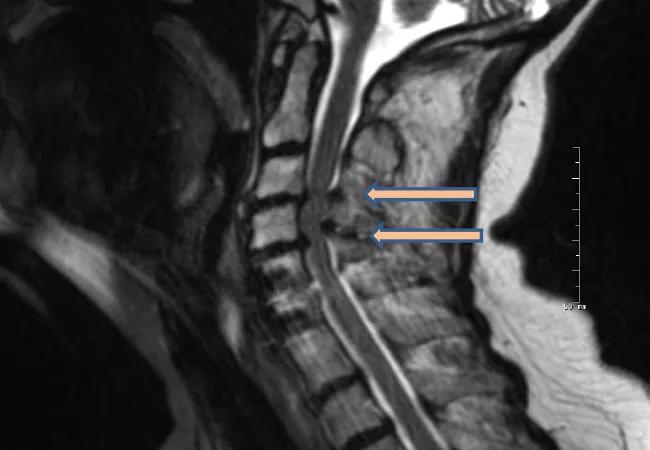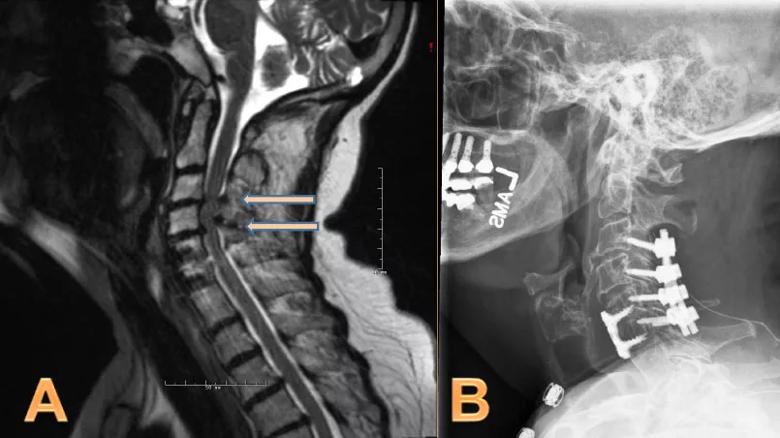PD’s effect on outcomes, and how it should shape the order of therapies

By Roy Xiao, BA; Jacob A. Miller, BS; and Ajit A. Krishnaney, MD
Cleveland Clinic is a non-profit academic medical center. Advertising on our site helps support our mission. We do not endorse non-Cleveland Clinic products or services. Policy
Patients with Parkinson’s disease (PD) may exhibit symptoms similar to those observed in cervical spondylotic myelopathy (CSM), including ataxia, weakness, and bowel or bladder dysfunction. These similarities present diagnostic and therapeutic challenges when PD and CSM coexist. While CSM is typically treated with surgical decompression (Figure), PD requires pharmacologic therapies and is expected to derive little benefit from decompression. This poses a dilemma for both neurologists and spine surgeons treating patients with PD who may have evidence of cervical spondylosis and myelopathy.
Clinical and quality-of-life (QOL) outcomes following cervical decompression in the PD population remain undefined. Defining these outcomes may improve patient management and help avoid unnecessary surgical intervention. To that end, Cleveland Clinic Center for Spine Health clinicians and researchers recently sought to investigate clinical and QOL outcomes following cervical decompression among patients with CSM with and without coexisting PD. We hypothesized that both groups would benefit from surgery but that patients with concomitant PD would experience inferior outcomes.

Figure. (A) Preoperative sagittal T2 MRI of a patient with coexistent cervical spondylotic myelopathy and Parkinson disease. Note the severe cervical stenosis and cord compression at C3-4and C4-5 (arrows). (B) Postoperative X-ray after the patient underwent laminectomies at C3 through C5 and extension of her fusion to C3 via a dorsal approach.
We retrospectively identified all patients with coexisting PD and CSM who underwent cervical decompression at Cleveland Clinic between June 2009 and December 2014 and then matched them to controls with CSM alone who underwent cervical decompression over the same period by the same team of spine surgeons . Matching was done on the basis of age, gender, American Society of Anesthesiologists classification, preoperative modified Japanese Orthopaedic Association score (mJOA) and operative parameters.
The primary outcome measure was postoperative improvement in mJOA score at patients’ last follow-up visit. The mJOA scale ranges from 0 to 18, with lower scores indicating greater neurologic disability. Two points was considered the minimum clinically important difference. Additionally, scores on the Nurick scale were collected to measure ambulatory status, with greater scores indicating greater impairment.
In a secondary QOL analysis, outcomes included QOL improvement as measured by the EuroQol 5 dimensions questionnaire (EQ-5D), the Pain Disability Questionnaire (PDQ) and the Patient Health Questionnaire 9 (PHQ-9). These measures were prospectively collected before and after surgery.
Simple and multivariable linear and logistic regression analyses were used to assess the impact of PD on primary and secondary outcomes.
Fifty-five patients met the study’s inclusion criteria: 11 with both PD and CSM and 44 with CSM alone.
We found that symptoms improved postoperatively in both cohorts; however, back pain, radiculopathy, and bowel/bladder dysfunction persisted among patients with PD relative to those without PD. Moreover, patients with PD experienced poorer improvement on both the Nurick (0.0 vs. –1.0, P < .01) and mJOA (0.9 vs. 2.5, P < .01) scales. PD was identified as a significant independent predictor of decreased improvement in patients’ functional status.
In the QOL analysis, while the control cohort experienced improvement across all measures examined, PD patients improved in only one (the PDQ). Despite an absence of significant differences between the cohorts in preoperative QOL, patients with PD had poorer QOL at last postoperative follow-up as measured by the EQ-5D (0.526 vs. 0.707 for controls; P = .01) and PDQ (80.7 vs. 51.4 for controls; P = .03), and a smaller proportion of PD patients achieved the prespecified minimal clinically important difference in EQ-5D (18 percent vs. 57 percent among controls; P = .04). No between-cohort differences in achieving a minimal clinically important difference were observed for the PDQ or PHQ-9.
Multivariable regression identified PD as a significant independent predictor of poorer improvement in EQ-5D (β = –0.09; P < .01) and of failure to achieve a minimal clinically important difference in EQ-5D (OR = 0.08; P < .01). Results of this QOL analysis were recently published in The Spine Journal.
This study is the first to characterize clinical and QOL outcomes following cervical decompression among patients with concomitant PD and CSM. Matched-pair analysis showed that patients with PD experienced diminished symptomatic and QOL improvement relative to controls.
Although decompression may have a role in alleviating pain-related disability in the PD population, this intervention appears to offer marginal benefit with respect to improving myelopathy and overall QOL. It is possible that only select patients with coexisting PD and CSM respond favorably to cervical decompression. Accordingly, preoperative pharmacologic optimization of PD should precede surgical correction of the spine. Further studies are needed to determine which patients with PD may benefit from surgical intervention for their myelopathy.
Mr. Xiao and Mr. Miller are medical students at Cleveland Clinic Lerner College of Medicine of Case Western Reserve University.
Dr. Krishnaney is a neurosurgeon in Cleveland Clinic’s Center for Spine Health and Department of Neurological Surgery.

Real-world claims data and tissue culture studies set the stage for randomized clinical testing

New grant-funded investigation illustrates impact and reach of Cleveland Clinic Brain Study

How the new longitudinal investigation could become the Framingham Heart Study of brain health

Pilot findings show good patient acceptance and safety, early hints of efficacy

Study finds high prevalence of symptoms, willingness to seek treatment

Panel outlines research priorities around a promising alternative to imaging markers

Suspected factors include antithrombotic intensity, time on device, presence of thrombocytopenia

Preclinical studies will assess whether method developed for stroke recovery curbs deficits after brain injury